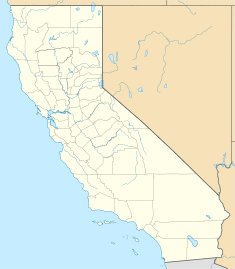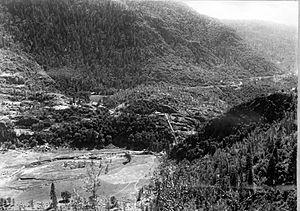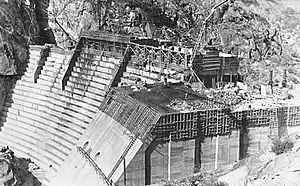O'Shaughnessy Dam (California) facts for kids
Quick facts for kids O'Shaughnessy Dam |
|
|---|---|
 |
|
|
Location of the O'Shaughnessy Dam in California
|
|
| Location | Tuolumne County, California, United States |
| Coordinates | 37°56′51″N 119°47′18″W / 37.94750°N 119.78833°W |
| Purpose | Water supply Hydroelectricity |
| Status | Operational |
| Construction began | August 1, 1919 |
| Opening date | May 24, 1923 |
| Owner(s) | San Francisco PUC |
| Dam and spillways | |
| Type of dam | Concrete arch gravity |
| Impounds | Tuolumne River |
| Height | 430 ft (130 m) |
| Length | 900 ft (270 m) |
| Elevation at crest | 3,812 ft (1,162 m) |
| Width (base) | 308 ft (94 m) |
| Reservoir | |
| Creates | Hetch Hetchy Reservoir |
| Total capacity | 360,400 acre⋅ft (444,500,000 m3) |
| Catchment area | 459 sq mi (1,190 km2) |
| Surface area | 1,972 acres (798 ha) |
| Power station | |
| Turbines | 3 x Pelton turbines at Kirkwood Powerhouse 2 x Pelton turbines at Moccasin Powerhouse |
| Installed capacity | 234 MW |
| Annual generation | 976 GWh |
The O'Shaughnessy Dam is a huge concrete dam in Tuolumne County, California. It stands about 430-foot (131 m) tall. This dam holds back the Tuolumne River, creating the Hetch Hetchy Reservoir.
This reservoir is located inside Yosemite National Park. It's about 160 miles (260 km) east of San Francisco. The dam and its reservoir are super important. They provide drinking water for over two million people. These people live in San Francisco and other cities nearby. The dam is named after Michael O'Shaughnessy, the engineer who led its building.
San Francisco needed more water, especially after a big earthquake and fire in 1906. The Hetch Hetchy Valley was chosen because it had clean water and could make electricity. But building a dam in a national park caused a lot of arguments. A special law was needed to allow it. This law said that public land could be used for public good.
Construction started in 1919 and finished in 1923. Water first reached San Francisco in 1934. Later, from 1935 to 1938, the dam was made even taller. This helped it hold more water and make more power. The dam and its water system are called the Hetch Hetchy Project. The water from Hetch Hetchy is very clean. It comes from a wild area in the Sierra Nevada mountains.
The Hetch Hetchy Dam caused the first big environmental fight in the US. Even today, people still debate if the dam should stay. Groups like the Sierra Club want the valley to be returned to its natural state. Others say keeping the dam is better for the economy and the environment.
Contents
Why Was the Dam Built?
In the late 1800s, San Francisco was growing fast. It needed more water than its local springs could provide. So, the city looked to the Sierra Nevada mountains. Snowmelt from these mountains fed many large rivers in California.
In 1890, San Francisco's mayor, James D. Phelan, suggested building a dam on the Tuolumne River. This river was a great source for water. In 1900, a government report also said the Tuolumne River was the "best source" for San Francisco's water. The city got rights to the river's water in 1901. But the government didn't approve building in Hetch Hetchy Valley at first.
Then, in 1906, a huge earthquake and fire hit San Francisco. This event showed everyone how badly the city needed a better water supply.
San Francisco looked at many water sources. Hetch Hetchy was chosen because it had a great spot for a dam. It also had lots of clean water and could make electricity. At that time, Hetch Hetchy was a quiet valley. Not many people visited it.
However, Hetch Hetchy Valley was part of Yosemite National Park since 1890. This meant it was protected land. Environmental groups, like the Sierra Club, loved the valley's beauty. They thought it was as beautiful as Yosemite Valley itself. Led by John Muir, a famous naturalist, they strongly opposed the dam.
In 1908, the government allowed San Francisco to build the dam. They said a lake would be even prettier than the valley's meadow. Also, the electricity made could help pay for the dam. Gifford Pinchot, a top forest expert, supported the project. He believed in using natural resources wisely for public benefit.
On December 19, 1913, President Woodrow Wilson signed the Raker Act. This law allowed the Hetch Hetchy project. It said that the water and power could only be used for public services, not for private companies. Even though it was very debated, the law passed. Many believed that public land should be used to help the public.
John Muir and the Sierra Club were very upset. But Muir died in 1914, soon after construction began. His Sierra Club continued the fight for many years. Muir famously said, "Dam Hetch Hetchy! As well dam for water tanks the peoples' cathedrals and churches." The Sierra Club argued that San Francisco had other options for water. For example, the Mokelumne River was a good choice. But San Francisco was determined to build in Hetch Hetchy.
Building the O'Shaughnessy Dam
Work on the Hetch Hetchy project began in early 1914. This was soon after the Raker Act was passed. The city hired John Ripley Freeman to plan the dam and water system. Michael O'Shaughnessy was in charge of building and designing the project. The dam was later named after him.
Before building the main dam, a smaller dam was built at Lake Eleanor. This dam provided water for the Early Intake Powerhouse. This powerhouse made electricity needed for the main dam's construction site.
Building the dam cost over $6 million. San Francisco paid for it using special bonds. To move workers and materials, the city built the Hetch Hetchy Railroad. This railway was about 68-mile (109 km) long. It followed the Tuolumne River canyon to the dam site.
The railway was built from 1915 to 1918. About 900 workers helped build it. It allowed supplies to be shipped directly from San Francisco. Special trains were used to handle the railway's steep hills and sharp turns.
Actual construction on O'Shaughnessy Dam started on August 1, 1919. Workers began clearing trees in Hetch Hetchy Valley. This was to prepare the valley for the future reservoir. A large tunnel was dug around the dam site. This tunnel sent the river's water away from the construction area.
The riverbed where the dam would stand was dug out over 100 ft (30 m) deep. This was to reach solid granite rock. A wall was built to stop water from leaking into the foundation hole. The granite was cleaned and made rough so the concrete would stick well.
The concrete for the dam was made nearby. Sand and rock came from the Hetch Hetchy valley. Cement was brought in by the Hetch Hetchy Railroad. Large boulders were also added to the concrete mix. This made a very strong material for the dam.
Starting in September 1921, the concrete was lifted up a 375-foot (114 m) tower. From there, it flowed down chutes by gravity to the building site. In total, over 398,516 cu yd (304,687 m3) of concrete was poured. The dam stood 226 feet (69 m) above the riverbed. The last concrete was placed in February 1922. The dam was finished in May 1923.
At that time, it was the second tallest dam in the United States. On May 24, 1923, the reservoir filled with water for the first time. Building the dam was a very hard and dangerous job.
The first electricity was made in 1925. But water didn't reach San Francisco until 1934. The dam was designed to be made taller later. This was in case more water and electricity were needed. And it happened! Between 1935 and 1938, the dam was raised by 85 feet (26 m). New parts were built to handle the extra height and water. This helped make more electricity.
The Dam and Reservoir Today
The O'Shaughnessy Dam reached its final size in 1938. It now stands 312 feet (95 m) above the riverbed. It is 430 feet (130 m) tall from its deepest foundation. The top of the dam is 900 feet (270 m) long. It has a 17-foot (5.2 m) wide road across it. The dam's wall is thickest at its base, reaching 308 feet (94 m).
The dam holds a huge amount of concrete and steel. Water flows from the reservoir into the Hetch Hetchy Aqueduct. Water can also be released through special gates on the dam. There is also a spillway with three large steel gates. When these gates are open, a lot of water can flow out quickly.
Behind the dam, Hetch Hetchy Reservoir stretches for 8 miles (13 km). It covers the Hetch Hetchy Valley. When full, the reservoir holds a massive amount of water. It covers an area of 1,972 acres (798 ha). The dam and reservoir get water from a large area of the Tuolumne River watershed. Other creeks also feed into it. You can reach Hetch Hetchy by road. The road is closed in winter when it snows.
Water from Hetch Hetchy also powers turbines. These are in the Kirkwood and Moccasin Powerhouses downstream. The Kirkwood Powerhouse started in 1967. It has three turbines and makes a lot of electricity. The Moccasin Powerhouse was rebuilt in 1969. It also has turbines and generates a lot of power.
The water from O'Shaughnessy Dam goes into the Hetch Hetchy Aqueduct. This aqueduct provides 85 percent of the drinking water for 2.4 million people. These people live in the San Francisco Bay Area. The dam provides about 237 million gallons of water every day.
The Hetch Hetchy area has unique geology. It has shallow soil over solid granite rock. This makes the water flowing into the reservoir very clear and clean. The watershed is also strictly protected. Boating and swimming are not allowed in the reservoir. However, fishing is allowed. Because of this, San Francisco's tap water is some of the cleanest in the United States. It doesn't even need much filtering. Many say it's better than most bottled water.
Dam Dimensions and Capacity
Here are some facts about the O'Shaughnessy Dam's size and capacity.
Before the dam was made taller in 1938:
| Foundation elevation | 3386 ft |
| Bottom valves elevation | 3508 ft |
| Initial crest elevation | 3726 ft |
| Storage capacity | 66,000,000,000 gallons |
| Drainage area | 294,000 acres |
| Reservoir area | 1590 acres |
After the dam was raised by 86 feet in 1938:
| Height above stream bed | 312 ft |
| Height above foundation | 425 ft |
| Crest elevation | 3812 ft |
| Crest length | 800 ft |
| Storage capacity | 117,300,000,000 gallons |
| Watershed area | 458 square miles |
| Reservoir area | 1872 acres |
Should the Dam Be Removed?
The O'Shaughnessy Dam has always been a topic of debate. People argue about its impact on the environment. They also discuss if San Francisco has followed the rules of the Raker Act. This act said that power and water from the project should only be for public use. But San Francisco has sold some power to a private company since 1925.
People who want the dam removed say it harms tourism and the local environment. They believe that if the reservoir was drained and the dam removed, the valley could return to its natural state. Visitors could then enjoy Hetch Hetchy's natural beauty again. They say there are other water sources for San Francisco. For example, the city has unused water in Don Pedro Reservoir.
However, those against removing the dam say it would be too expensive. It could cost billions of dollars. They also point out that removing the dam would mean losing clean hydroelectric power. This power would have to be replaced by burning fossil fuels, which cause pollution.
While there are other water options, none are as pure as Hetch Hetchy's water. Also, there's no guarantee the valley could be fully restored. The original valley floor was shaped by thousands of years of care by native peoples. Without this, a forest might grow instead of the famous meadows. Finally, more tourists could cause their own environmental problems, like in the crowded Yosemite Valley.
Despite the ongoing arguments, most people in San Francisco don't support removing the dam. In 2012, San Francisco voters rejected a plan to study removing the dam. About 77 percent of voters were against it. This plan would have cost $8 million to study how to replace the water. It also suggested draining the reservoir by 2035.










